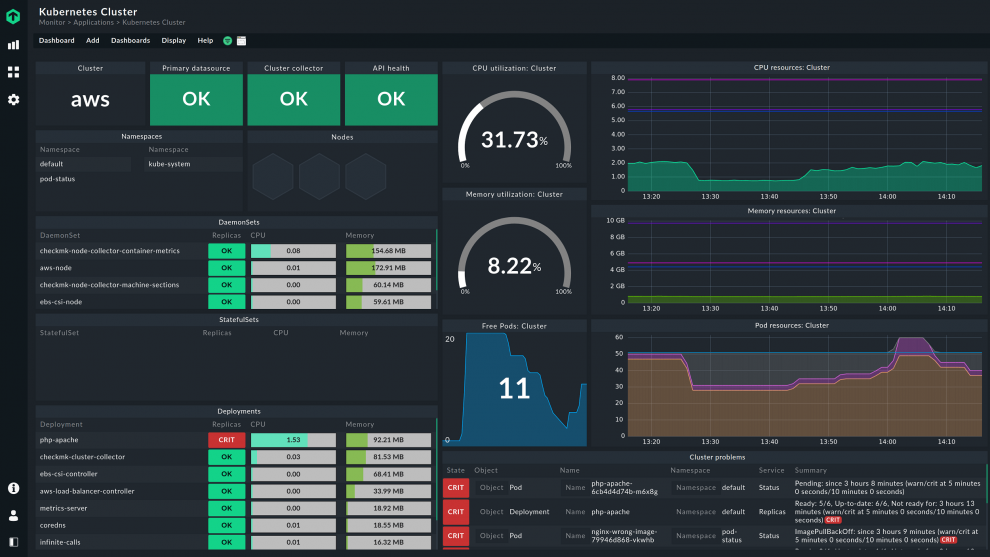If you are monitoring your systems with Checkmk Raw, you may be at the point where you are ready to move to Checkmk Enterprise. Checkmk Enterprise includes all the benefits of Checkmk Raw, but also offers more power and is specifically designed for scalability. Moreover, many additional features, such as numerous automation options, will make your life easier.
In this blog, I'll discuss the key differences between both editions and help you decide whether it makes sense for you to switch. I'll also explain a few things that you should keep in mind when migrating.
TL;DR:
Checkmk Enterprise builds on the open-source Raw edition by adding performance improvements, automation, and scalability for larger or dynamic infrastructures.
- Switching to Enterprise reduces CPU usage dramatically thanks to the Checkmk Micro Core, while remaining compatible with existing Nagios plug-ins.
- Enterprise automates repetitive tasks like agent updates and reporting, saving time and simplifying large-scale monitoring.
- Migration is low-risk, with familiar interfaces and clear upgrade steps, and trial versions allow testing enterprise features before committing.
Value of your time and hardware costs are the most important factors
The performance of your monitoring depends to a large extent on the monitoring core. It is the central engine of a monitoring system and, for example, initiates checks, provides status information to the GUI or detects status changes.
Here, Checkmk Enterprise relies on the Checkmk Micro Core (CMC), a high-performance engine with a high-performance software architecture developed by Checkmk. Checkmk Raw, on the other hand, uses the core of the open source project Nagios. This is a kind of standard engine for monitoring that works reliably but lags behind modern approaches, especially in terms of performance.
When the monitoring reaches a certain size, users notice performance problems and switch to Checkmk Enterprise to save the budget for new hardware resources. Before and after comparisons of operational monitoring environments show that after switching to the CMC, CPU utilization of Checkmk host servers dropped from about 80% to less than 20%.
If you notice that your monitoring host server is reaching its resource limit, this might be a good time to switch to Enterprise. Despite the basic optimization, however, the CMC is compatible with all Nagios legacy checks. So you can continue to use your monitoring plug-ins.
The CMC can run more checks per second, which makes Checkmk Enterprise optimal for monitoring Kubernetes. Checkmk Raw can also monitor dynamic assets, but due to is architecture its capabilities are limited.

Additional features of Checkmk Enterprise
Another argument for switching to Enterprise are the extensive automation features and better management options. For example, Checkmk's reporting feature can create custom reports for you in PDF format and comes with a number of pre-built templates. If you currently take screenshots of dashboards or hosts manually, you can completely automate this process, saving you valuable time.
With Checkmk Enterprise, you can also take advantage of the Agent Bakery. This allows you to create (or "bake") customized agent packages and to automatically update the configuration of your Checkmk agents. When it comes to server monitoring, the Agent Bakery therefore takes a lot of manual work off your hands.
Checkmk Enterprise comes with many other additional features. For example, you can use a large set of integrations with other enterprise solutions such as Jira, ServiceNow, ntop or DataDog. It also offers better dashboarding and the ability to automatically create hosts in your monitoring via dynamic host configuration.
Upgrade comes as an update – without any risk
If you are considering a switch, you do not need to worry about the workload. Upgrading is no different from the normal update process to a new Checkmk version. The steps are described in detail in the Checkmk user guide. There are only some default settings for modules and features that you need to adjust once. For example, for Checkmk sites that you created with Checkmk Raw, you will need to adjust the monitoring core after switching to Enterprise.
Visually, the Raw and the Enterprise user interfaces are almost identical, and you will easily find your way around. You can continue using the configuration of your monitoring, and the changing process will be quick. This allows you to make a risk-free switch without needing additional training.
You can also migrate from Checkmk Enterprise back to Checkmk Raw, but you must first ensure that you do not use any features in the configuration that do not exist in Checkmk Raw.
Go for a test
How beneficial the enterprise features are for you depends on your individual monitoring environment. Therefore, the safest and most reliable option is a personal trial run. You can use the Checkmk Trial to test all the capabilities of Checkmk Enterprise. Often, only the practical test shows how much time and resources you save with Checkmk Enterprise.
Most advantages of the many small things only reveal themselves in a test run. For example, there is already an Ansible collection, which you can use to further automate the management of Checkmk agents. Checkmk Enterprise also offers the notification spooler, which eliminates notification delays.
With Checkmk Enterprise, you also have the option to book a support package. This allows you to benefit from the experience of our Checkmk consultants. For example, if you have set up a large monitoring environment with Checkmk Raw or another monitoring solution, we can help you migrate to Checkmk Enterprise.
Best practices for migrating from Raw to Enterprise
If you are considering a migration to Checkmk Enterprise, you should keep the following points in mind.
Check the number of your monitoring services
You purchase an annual Enterprise subscription, and get an invoice based on the number of services monitored. The Checkmk sales team usually audits the number of services once a year to avoid under- or over-licensing. You can check the necessary budget on the pricing page and also order a subscription directly on the website.
Make backups of your configuration before the migration
The upgrade is simple, nevertheless you should make a backup of your Checkmk configuration before you make some changes.
Update all Checkmk sites to the latest version
Since you are ideally migrating to the latest version of Checkmk Enterprise, your current monitoring environment with Checkmk Raw must also be up-to-date. The latest version ensures that known vulnerabilities are fixed and that you can use all new features. Under no circumstances should you use a Checkmk version that tribe29 no longer actively maintains. An overview of the supported Checkmk versions can be found in the Checkmk manual.
In order to migrate your configuration safely, all Checkmk sites of your current monitoring environment must be up-to-date with Raw. Especially for distributed monitoring, you should not use different Checkmk versions at the same time. Do not skip versions, or you may experience compatibility issues. For example, if you are using Checkmk version 1.6, you must first update to Checkmk 2.0 before you can switch to Checkmk 2.1.
Reconsider your monitoring processes
Especially when switching to Checkmk Enterprise, you should say goodbye to outdated approaches. For example, many users use outdated plug-ins in Checkmk. If you still used Nagios plug-ins in Checkmk Raw, for instance, you should check if there is an official check plug-in when switching to Checkmk Enterprise. These work more efficiently and are regularly maintained by the Checkmk development team.
Also, some users manually configure steps that Checkmk can do automatically. Especially if you are considering a switch to Enterprise, you should keep an eye on options for automatic configuration. For example, you can configure Checkmk via the Rest API.
Conclusion: Checkmk Raw and Checkmk Enterprise have their advantages
There are good reasons to choose Checkmk Raw. Thanks to 100% open source technology, it offers maximum control and unparalleled extensibility. Checkmk Enterprise additionally offers better performance, numerous automation options and other advantages. In the end, it is up to you to decide. However, with the Checkmk Trial, you have a good opportunity to test all enterprise features in advance.
